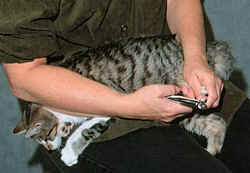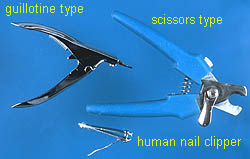Archive for October, 2009
Protecting your dog from predators. An enclosed pet exercise pen could help!
 The closer that you live near open spaces, the more likely that your pets can become victims of an unwanted predator. According to the California Veterinary Medical Assn. (CVMA), the problems posed by large predators, such as coyotes and mountain lions, as well as minuscule ones, such as fleas, ticks and mosquitoes, may be particularly severe in spring and summer when pets spend more time outside in the yard or traveling with their owners. I’ve even heard of hawks swooping down and taking small dogs right out the their yard. This seems crazy but it does happen. If you live in an area where hawks are present. Do not leave you pet outside alone! I’ve also heard of alligators attacking small dogs. So what can you do to protect your pet? The best protection is to keep your pet indoors. Especially at night. You may consider an enclosed pet exercise pen which you may have to make yourself. Another way is an enclosed yard with a fence at least six feet high although this will not protect against the hawks. Some other measures might be to install motion detectors along the perimeter of your home. Most pets seem to shy away from lighted areas. Always feed your pet indoors. Trim overgrown trees and bushes that provide cover for coyotes. The CVMA suggests making sure your pets are always on a leash and are properly trained, especially when walking in areas where they might encounter predators.
The closer that you live near open spaces, the more likely that your pets can become victims of an unwanted predator. According to the California Veterinary Medical Assn. (CVMA), the problems posed by large predators, such as coyotes and mountain lions, as well as minuscule ones, such as fleas, ticks and mosquitoes, may be particularly severe in spring and summer when pets spend more time outside in the yard or traveling with their owners. I’ve even heard of hawks swooping down and taking small dogs right out the their yard. This seems crazy but it does happen. If you live in an area where hawks are present. Do not leave you pet outside alone! I’ve also heard of alligators attacking small dogs. So what can you do to protect your pet? The best protection is to keep your pet indoors. Especially at night. You may consider an enclosed pet exercise pen which you may have to make yourself. Another way is an enclosed yard with a fence at least six feet high although this will not protect against the hawks. Some other measures might be to install motion detectors along the perimeter of your home. Most pets seem to shy away from lighted areas. Always feed your pet indoors. Trim overgrown trees and bushes that provide cover for coyotes. The CVMA suggests making sure your pets are always on a leash and are properly trained, especially when walking in areas where they might encounter predators.
 Urinary incontinence or urinary leaking is a common canine condition with causes ranging from infection to diabetes to abnormal development. Tests will help determine the seriousness of your dogs problem. There are certain conditions like irritation or inflammation that can cause incontinence. These conditions are easily treatable. Another common cause especially in spayed females dogs and geriatric dogs is a weak bladder sphincter. This condition generally responds well to pet medication so most incontinent pets do not need to suffer. If your dog is diagnosed with a more serious problem, surgical reconstruction of the lower urinary system will help protect your pet and those expensive carpets! So be patient when slipping on that dog leash and have the paper towels handy.
Urinary incontinence or urinary leaking is a common canine condition with causes ranging from infection to diabetes to abnormal development. Tests will help determine the seriousness of your dogs problem. There are certain conditions like irritation or inflammation that can cause incontinence. These conditions are easily treatable. Another common cause especially in spayed females dogs and geriatric dogs is a weak bladder sphincter. This condition generally responds well to pet medication so most incontinent pets do not need to suffer. If your dog is diagnosed with a more serious problem, surgical reconstruction of the lower urinary system will help protect your pet and those expensive carpets! So be patient when slipping on that dog leash and have the paper towels handy.
Clipping your Cats Nails if her cat scratching post isn’t the only thing shes scratching on!
 If your cat is like mine, trimming her nails is certainly not an easy task. My cat Mollie is fine, until she sees the clippers. My cat Millie will have none of it and will not allow her nails to be clipped! So how do you perform this “ungodly” task especially if your cat is clawing more than her cat scratching post? This information was obtained by Washington State University’s College of Veterinary Medicine. Most cats do not like having their nails clipped. Start by trimming their nails at a young age so that they get used to the process. To restrain a cat in your lap, use your forearms draped over the cat’s neck and hind-end to keep the cat in your lap. The clipper is held in
If your cat is like mine, trimming her nails is certainly not an easy task. My cat Mollie is fine, until she sees the clippers. My cat Millie will have none of it and will not allow her nails to be clipped! So how do you perform this “ungodly” task especially if your cat is clawing more than her cat scratching post? This information was obtained by Washington State University’s College of Veterinary Medicine. Most cats do not like having their nails clipped. Start by trimming their nails at a young age so that they get used to the process. To restrain a cat in your lap, use your forearms draped over the cat’s neck and hind-end to keep the cat in your lap. The clipper is held in  the right hand. There are several kinds of nail clippers that you could buy, a guillotine type, a scissors cut, and a standard human fingernail clipper. I use a scissors type of clipper because my cats nails usually curve and for me, they are easier to use. The guillotine or regular human fingernail clipper may be easier for you. Hold the trimmer in your right hand if you are right handed. Cats have retractile claws so you need to gently squeeze the toe between thumb and forefinger to expose the claw. Most cats have light colored claws and you can see the pink veins that supply blood to the area. You do not want to cut down there. I recommend that you trim right at the curve. If you trim down too far, you will cut the vessel, the claw will bleed and your cat will experience pain. The sharper the blade, the cleaner the cut.
the right hand. There are several kinds of nail clippers that you could buy, a guillotine type, a scissors cut, and a standard human fingernail clipper. I use a scissors type of clipper because my cats nails usually curve and for me, they are easier to use. The guillotine or regular human fingernail clipper may be easier for you. Hold the trimmer in your right hand if you are right handed. Cats have retractile claws so you need to gently squeeze the toe between thumb and forefinger to expose the claw. Most cats have light colored claws and you can see the pink veins that supply blood to the area. You do not want to cut down there. I recommend that you trim right at the curve. If you trim down too far, you will cut the vessel, the claw will bleed and your cat will experience pain. The sharper the blade, the cleaner the cut.
If the claw is cut too short, you can use a styptic pencil containing silver nitrate to stop blood flow, although many animal object to this the styptic pencil as much, or more, than claw cutting. The black end of the stick is held to the bleeding nail and gently rotated.
Even without any treatment the nail should stop bleeding in about 5 minutes or less.
You may have to cut a few nails at a time if your cat gets restless or jumps off your lap. Mollie usually lets me cut a few but then jumps off my lap when she’s had enough. If this happens, wait a day or so and try again.